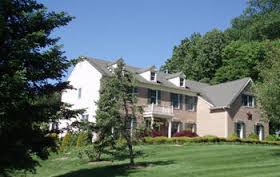
Single Family Home
A single family detached home is a free-standing residential building. Most single family homes are built on lots larger than the structure itself, adding an area surround the home known as the yard. Some single family homes have garages that are attached or detached or both. Some single family homes have driveways leading to the garages. Some driveways are private and some are shared with a neighbor.
There are advantages and disadvantages to single family detached homes. Advantages are that the entire space around the building is private to the owner and family, in some cases (depending on municipality zoning guidelines) you can add on to the existing house if more room is needed. Disadvantages of owning a single family detached home include being responsible for all maintenance and repair costs (interior and exterior).
Some single family detached homes are part of a subdivision and may be a member of a Home Owners Association being required to pay monthly, quarterly or annual fees (for things such as exterior maintenance of the property and/or grounds, insurance, snow and/or trash removal, etc.)
Multi-Family Home
Duplex or semi-detached homes are typically one building consisting of two separate “houses.” They may be side by side or one on top of another. Each often have separate entrances and typically without common inside areas. Each of the two houses typically has separate owners.
A town house is a house attached to any number of other town houses each of which may have multiple floors, commonly side by side each with their own separate entrances. Each such house has its own owner.
An Apartment Building is a building with multiple apartments. There can be multiple apartments on each floor and there are often multiple floors. Apartment buildings can range in many sizes, some with only a few apartments, others with hundreds of apartments on many floors, or any size in between. There are often inside hallways and inside entrances to each apartment, but outside entrances to each apartment are also possible. An apartment building can be owned by one party and each of the apartments rented to tenants or each of the apartments can be owned as a condominium by separate parties.
A Mixed Use Building is a building with space for both commercial, business or office use and space for residential use. Possible arrangements include the commercial/ businesses use on the first or first couple floors and one or more apartments or residential spaces on the upper floors. Another possibility is to have the commercial/business area up front and the residential area in the back. Some or maybe all of the space may be used by the owner or some or all of the business and residential units may be leased by the owner. Condominium ownership is also possible.
Condominium
Technically, a condominium is a collection of individual home units along with the land upon which they sit. Individual home ownership within a condominium is construed as ownership of only the air space confining the boundaries of the home. The boundaries of that space are specified by a legal document known as a Declaration, filed of record with the local governing body. Typically these boundaries will include the dry wall surrounding a room, allowing the homeowner to make some interior modification without impacting the common area. Anything outside this boundary is held in an undivided ownership interest by a corporation established at the time of the condominium’s creation. The corporation holds this property in trust on behalf of the homeowners as a group—it may not have ownership itself.
It is also possible for condominiums to consist of single family dwellings; so-called “detached condominiums” where homeowners do not maintain the exteriors of the dwellings, yards, etc. These structures are preferred by some planned neighborhoods and gated communities.
Land
In real estate, a lot is a tract or parcel of land owned or meant to be owned by some owner(s). Possible owner(s) of a lot can be one or more persons or another legal entity, such as a corporation, organization, government or trust. A common form of ownership of a lot is called fee simple. Land, as in also true with buildings, may be required to fit certain zoning requirements as directed by the local municipality.
Like most other types of real estate, lots owned by private parties are subject to a periodic real estate tax payable by the owners to local governments such as a county or municipality. Real estate taxes are assessed based on the value of the real property.
